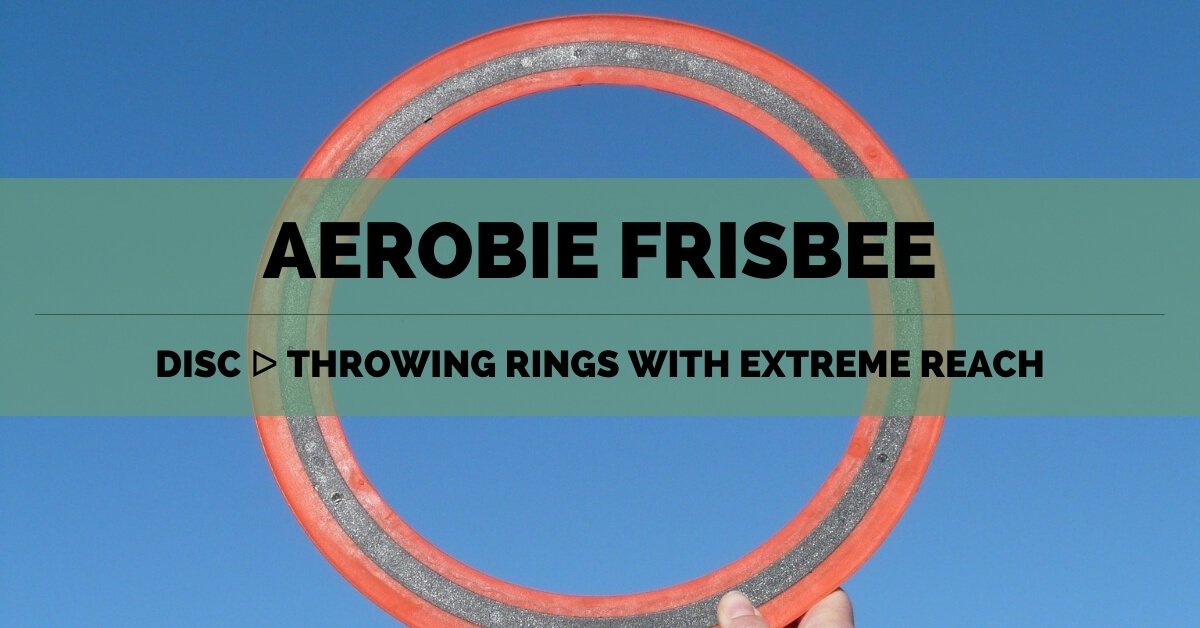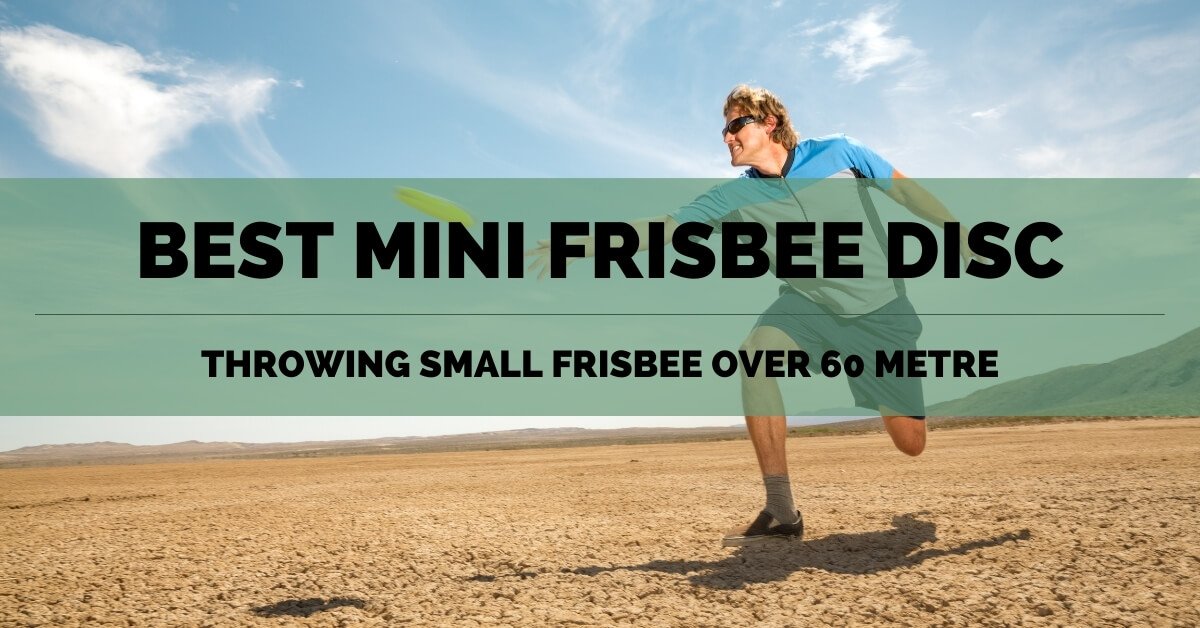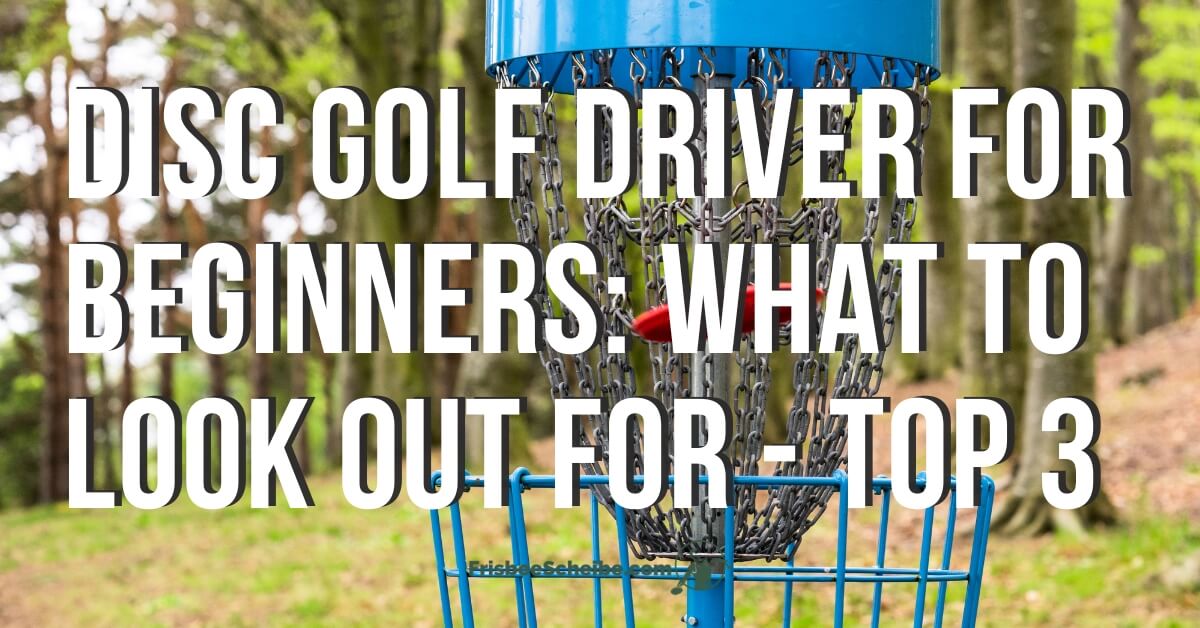You and your dog are a great team? Do you are enthusiastic about being out in the fresh air? Your dog is a real powerhouse, but also wants to be challenged mentally? And you are looking for a dog toy that cleverly combines play, fun and sport? Jow about learning Dog Frisbee? With the right throwing techniques and the right dog frisbee indestructible toy, you’re guaranteed to get some variety on the green!
What is Dog Frisbee?
Although you might think so, dog Frisbee / Discdogging as it is also called, is not a completely new sport. Frisbee player Alex Stein came up with the idea more than 30 years ago. The reason: his dog Ashley Whippet was as enthusiastic about the discs as he was. And why shouldn’t he combine the beautiful with the useful? Exactly! In the meantime, there are official leagues in America in which professional dog frisbee is played.
But of course, professional sport is not a background obligation for learning Dog Frisbee. Instead, the fun of the game should be the main focus. Not all Frisbee players have lofty ambitions and this also applies to their dogs. So first keep the disc flat and start slowly. This is the best way to see what works and where the end of the line is. However, Discdogging can be somewhat addictive. The principle is quite simple. You throw a special dog Frisbee disc, your four-legged friend catches it in flight and brings it back to you.
Admittedly, this sounds quite easy at first. At the same time, it requires a lot of timing and skill on the part of the human and the dog. At least if you want it to be more than just a simple throw and snap. Which tricks and which execution you want to train in detail will certainly become clear in the course of time.
Of course, in the course of this article you will get a small foretaste of the different ideas and techniques. However, I would first like to tell you why it is really worthwhile to give disc dogging a try.
Which disc for learning dog frisbee?
The fact that the sport is called dog frisbee is not only because your dog is one of the main players. The dog frisbee disc* itself is also adapted to the physical needs of the animal and is therefore always preferable to a ‘normal’ disc. Heavy frisbees made of hard plastic, with holes, spokes or other devices attack the teeth of the four-legged friend. In addition, they can splinter if bitten too hard or cause teeth to break if they are not gripped properly. Not a nice idea, is it? And easily avoidable by using more suitable frisbees.
Here are some aspects that distinguish better models:
- Materials: rubber (natural rubber), silicone, soft plastic or fabric. Bite-resistant rubber discs such as those from Kong or Trixi are recommended, especially for dogs that grip quite firmly at first. As soon as this improves with a little training, soft plastic discs that fly even better are also worthwhile.
- Size: Discs for small dogs usually have a diameter of 5,9 to 7,1 in. and a weight of about 2,5 oz.. Larger dogs play best with 8,7 to 9,4 in. diameter Frisbees, which weigh a good 3,9 to 5,3 oz…
- Additionally clever and motivating: dog frisbee discs that can float or be filled with food …
And a little tip on the side: If you have several discs available, you don’t always have to retrieve the only disc by running yourself in the beginning if the dog hasn’t retrieved it as desired right away

- flying disc designed specifically with dogs in mind
- easy to grip, throw accurately, and catch
- Disc is puncture and tear resistant to ensure long-lasting use
Manufacturer of high quality Dog Frisbee discs
When choosing dog frisbee discs, quality clearly beats price. That’s why you shouldn’t save at the wrong end. Unbreakable and suitable for dogs’ teeth should really be unbreakable and suitable for dogs’ teeth. Therefore: Hands off untested and unknown brands. Manufacturers you can rely on, however, include…
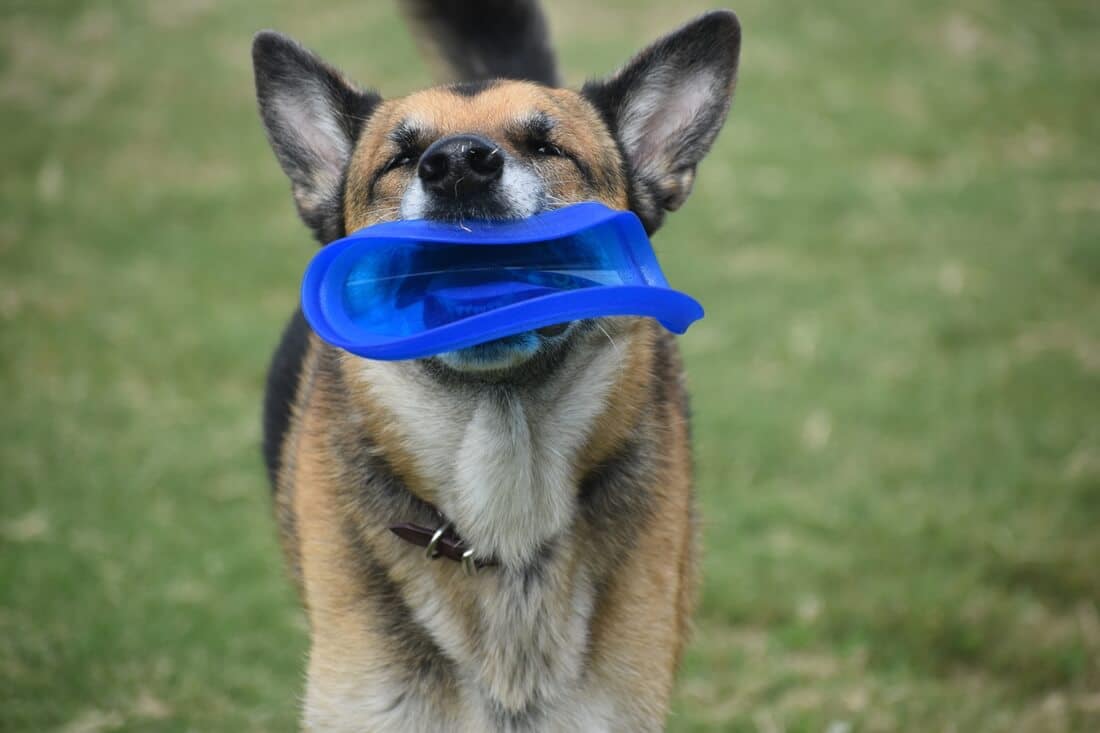
Thanks to their specialisations and the large selection in the respective ranges, you are guaranteed to find the right discs for you and can go out to play in the meadow with a clear conscience.
For which dogs is Dog Frisbee suitable?
Many dogs are enthusiastic about dog frisbee – and it doesn’t matter whether they are particularly small or large. Whether Jack Russell or German Wirehaired doesn’t necessarily make the difference. Nevertheless, you should consider a few things.
For disc dogging, the dog must be fully grown.
This means (depending on the breed): No training for the first 18 months or a little longer. After all, you don’t want to damage his joints and bones unnecessarily by jumping and landing too early. Therefore, wait for the skeleton to build up healthily and strengthen muscles and co. in other ways, and then take off without a care in the world.
Large and heavy dogs that tend to suffer from hip problems are not the best candidates
The same applies to them as to puppies – even if the causes are different.
Is your four-legged friend getting enough air?
This may sound a bit strange at first. But if you take a closer look at a pug or other short-nosed dogs … it quickly becomes logical that shortness of breath is not necessarily the best helper during an intensive sport. However, this does not mean that a pug per se is not suitable for dog frisbee! After all, his bone structure lends itself to this.
Your dog must not freak out
Some dog breeds, such as Border Collie, despite their otherwise excellent suitability for this dog sport, tend not to find an end and at some point virtually spin on the edge. Of course, this does not have to be the case in every individual case. Nevertheless, make sure to play with your dog only as long as it is good for him and as long as an end is possible.
Conclusion
Learning Dog Frisbee is suitable for adult, not too heavy dogs without respiratory or hip problems. As long as you have your dog checked by a vet before you start training and he gives you the OK, there is nothing to stop you training. Challenging the dog is perfectly fine – it should just not be too much of a challenge. In this respect, it is practical that there are no rigid guidelines for disc dogging. This means you can tailor the exercises to your furry buddy and you’ll both be happy.
What makes dog frisbee so exciting and worthwhile?
Roughly summarised, there are three aspects…
- The human-dog bond is strengthened. Finally, your dog learns to trust you and your skills and commands. In return, you practise expressing yourself clearly at the right moments. The result: a good team performance that makes both you and your dog happy.
- The fitness aspect should not be underestimated. Logically, in relation to the dog, this is of course immediately apparent. After all, there is a large portion of running, stopping, changing direction and jumping on the programme. This demands all muscles and keeps you fit accordingly. But you will also be surprised. Because if you want to teach your dog to play Frisbee, it’s not enough to stand in one place and throw at a disc. Especially in the beginning, you will certainly be on the move a lot to pick up a disc that has been left behind …
- A clever head is just as important as strong legs. It can be quite a challenge for a dog to react quickly and correctly to a sudden command. A clear case of “practice makes perfect”. But who knows, maybe in the course of time you two will develop telepathic skills!
In short, it’s the variety that makes learning Dog Frisbee appealing. The different challenges and ever-changing situations mean that you and your furry darling will certainly not get bored. And that’s half the battle when it comes to dog sports, isn’t it?
Dog Frisbee Training: Step by Step Guide
You’ve probably seen them before: the photos and videos of dog frisbee players and their dogs jumping over their heads or bodies and jumping off their bodies. But it’s a bit of a long way to get there, and it requires a lot of practice and patience. That’s why in this article I would like to start with the basics and introduce you to the four essential throwing techniques. But before we get started, here is some helpful information on the warm-up programme.
Make sure that your four-legged athlete has not eaten anything for about three to three and a half hours before training. This way you don’t have to worry about indigestion or other unpleasant effects such as sudden vomiting when jumping and/or landing.
Play with each other without Frisbee at first. Running and dexterity exercises such as slalom and the like can be used for this. A bit of fetching or hide and seek will ensure that your dog is already evenly warmed up. On top of that, he is concentrated without being overly nervous.
Are you fit enough to throw a Frisbee yourself? If not, start with some solo exercises on the grass. Uncoordinated throws are even more difficult for your four-legged friend to catch. And especially at the beginning, you should make it a little easier for him for motivational reasons.
Everything clear? Then you can start with the training.
Keep one important thing in mind: Don’t overtax your dog with too long sessions. Five minutes at a time, two or three times a day, is more effective than a quarter of an hour at a time. This will keep the Frisbee interesting for him for a longer period of time. Especially if you end the session at a time when he is still very attentive.
Das Video wird von Youtube eingebettet. Es gelten die Datenschutzerklärungen von Google.
The drive
As soon as you get into the actual learning of Dog Frisbee, get all the discs ready, but don’t let the dog take them without your permission. Show him a Frisbee, take a stable stance and hold the disc a little distance away at his head height. Now lure him to come behind the disc and show him that he should grab the disc – preferably in combination with the command “Catch”. Repeat the process a few times, holding the Frisbee at different heights so that he gets used to it not always being at his head height. If this works smoothly, it is time for the next steps.
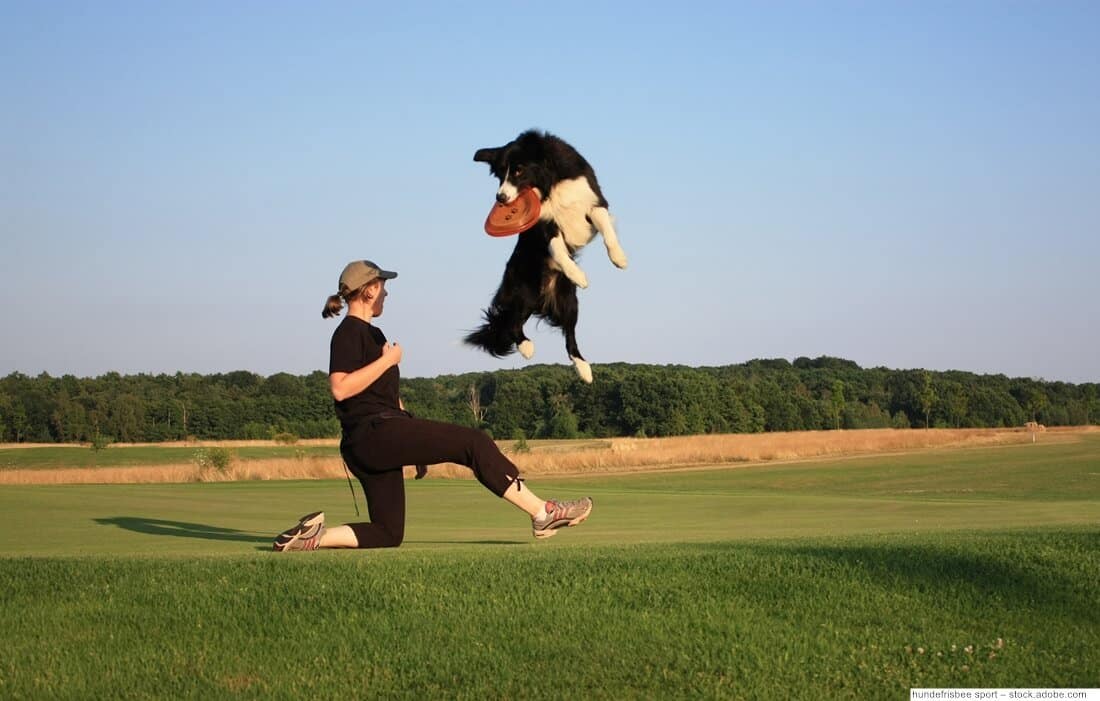
Dog Frisbee Throwing Techniques
Roller
The first throw is the roller, which is the basic entry throw par excellence. It is not even a throw in the true sense of the word. After all, you let the toy roll across the floor – away from your dog. This can take a while, but if you succeed, you should reward your dog with a lot of petting or perhaps a treat or two. It is important to remember that the dog only starts running on your command – and the throw always leads away from your four-legged friend. That’s why the dog should always stand behind you or at least next to you so that you can keep a close eye on the disc.
In terms of technique, you can use the backhand as a guide. Take the disc in your throwing hand and place your four fingers on the inner edge of the disc. The thumb is on the upper side. Now bend the corresponding wrist until the disc and forearm touch. Then turn the wrist and the disc upwards at right angles and move the arm upwards, releasing the disc. As a result, the disc should reach the ground after a good one to two metres and roll straight ahead from there, ready to catch.
Floater / lifter
If your dog is comfortable with the roller, the lifter is the next step. It is similar to the backhand throw just mentioned. However, you do not throw the Frisbee towards the ground, but loosely upwards in the air. Ideally, the Frisbee will then float slowly downwards relatively close to your body. You can achieve this by giving it a little upward swing by hand before throwing it. For this to work, however, you must not grip it too tightly or too loosely. An ideal exercise to train your dog to catch the Frisbee from the air!
Backhand
As already mentioned, the backhand throw is the basis for the roller. If you want to make more out of it when learning Dog Frisbee and especially create more throws, go ahead.
To do this, return to the basic position and hold the Frisbee so that the top of the Frisbee is at a slight angle in front of your body. This has the advantage that it stabilises itself in the air after the throw. Now fold in your wrist and bring your throwing arm up to shoulder height. Your shoulders as well as your throwing arm and hand form a straight line aligned with the target. You extend your wrist just before throwing the Frisbee, which provides the ideal spin. At the same time, the momentum of the throw comes from your backswing, not from your wrist.
Forehand throw
Does the forehand seem a bit Spanish to you when learning Dog Frisbee? That could be, of course, because it’s not as much on your mind as the backhand. However, it’s not a problem if you think about tennis and know how the forehand works there.
First place the middle or ring finger plus fingertip in the inner edge of the Frisbee. At the same time, place your thumb on the top so that the disc is stable. Now stand in front of the target and make sure your legs are loose and shoulder-width apart. Adjust the Frisbee slightly and keep the throwing arm and elbow at a right angle. Your upper arm is at the side of your body and you only bring your forearm backwards – including the hyperextended wrist. During the throw itself, you move the forearm forward accordingly and release the wrist forward in a sweeping motion just before the final position. At the same time, your fingers press on the inside edge of the Frisbee, which gives the disc the desired spin.
Combinations
You and your dog are experts in the individual basic throwing techniques? Then you can of course try them out in the most diverse combinations or enrich them with jumps and other tricks such as turns and slam-less runs. Especially in this area, there are no limits to the imagination, which makes the guidebook literature virtually endless. In any case, practise all the individual components with your dog first. This way he always knows what to do, even with mixed exercises.
Das Video wird von Youtube eingebettet. Es gelten die Datenschutzerklärungen von Google.
Dog Frisbee Sport Disciplines
Your dog is an enthusiastic disc dogger and you enjoy being with him on the course? Congratulations! It can go on like this – if you want, maybe even in a suitable official group and possibly even in a competition team? If you are interested in this, a trial lesson at a suitable club is definitely a good idea. Nevertheless, I would like to tell you in advance in which variants professional dog frisbee is played. (The first two are officially recognised competition techniques).
- Freestyle: In this variant you develop a choreography of about two minutes to a music of your choice, throwing between seven and ten discs, depending on the rules. You will present different throwing techniques (forehand and backhand, roller and floater, butterfly, upsidedown, etc.) as well as dog tricks such as flip, zigzag, over, etc. In the judging, the jury will look at the creativity, the drive of your dog, the complexity of your throws, the flow of the performance and the reactions of the audience.
- Mini-Distance: Here you have either 60 or 90 seconds to play as many discs as possible on a field with different scoring zones. Points are awarded to you and your dog if he catches the disc and brings it back to you. This is important because only one disc is used. Extra points are awarded for air catches and discs in the bonus landing zone.
- Long Distance: This version works without a limit of time and with three discs. As the name suggests, the Frisbees must fly as far as possible before they are caught by the dog. The dog is only allowed to cross the starting line after the disc; the furthest caught throw is the winner.
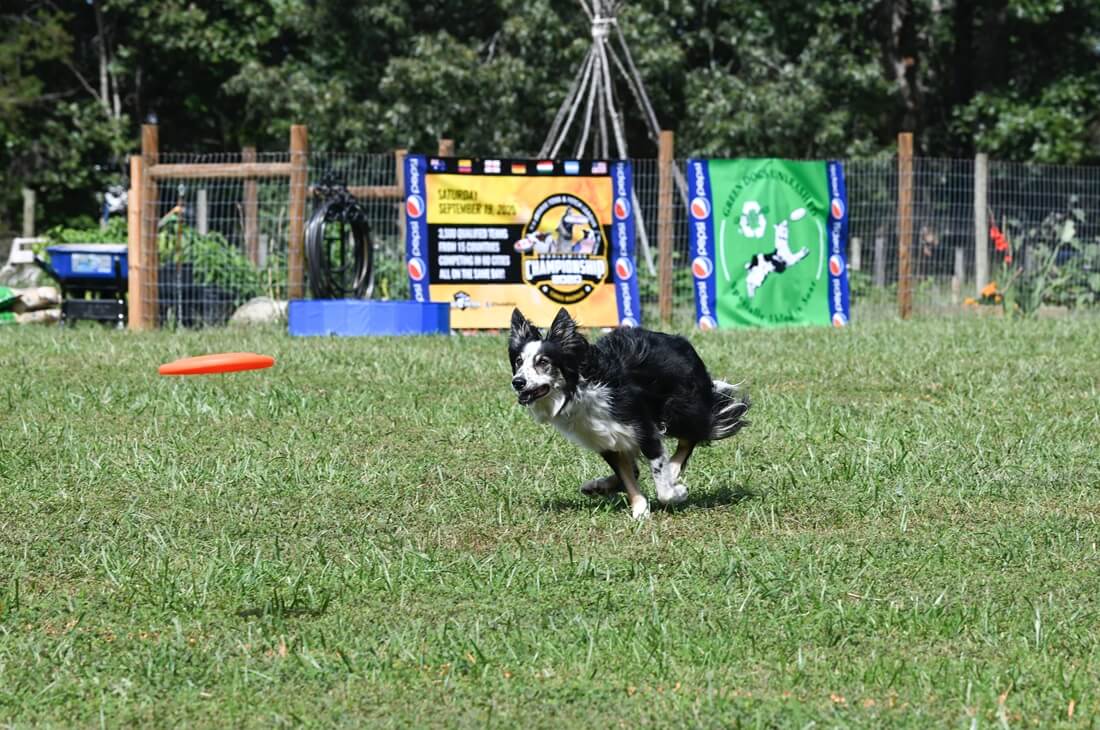
requently asked questions & answers
Speaking of going to the meadow: A soft surface without holes is the best choice for learning to play dog frisbee and also afterwards. Whether it’s a meadow without traffic, grass, sand or powder snow – all these options are possible. The main thing is that your dog doesn’t fall over in any hollows, doesn’t overstress his bones or joints when jumping and landing, and doesn’t accidentally run into dangerous objects. Conversely, this means: Please do not play on concrete, asphalt, gravel or frozen meadows. And of course, don’t play near roads where your pet could accidentally get caught in his training zeal.
You can practise dog frisbee with dogs that are already fully grown and therefore have a solid muscle, joint and bone structure. This is the case with young dogs after 18 months or a little later, depending on their breed. But even then, you should first familiarise them slowly with the easier basic techniques such as the roller or floater and not immediately demand the highest and most difficult jumps from them. A careful increase is the best and most sustainable way.
As long as you train with a dog that is basically up to the demands of dog sports (no dogs that are too young or heavy with joint, bone and/or breathing problems), dog frisbee is a great leisure activity. It challenges strength, coordination, dexterity and reaction time in a confidence-building way.
However, the basic prerequisites are that you pay attention to the right surface and teach your dog to jump and land in a way that is easy on the joints. Only when he lands on all his paws at the same time will his weight be distributed evenly. And of course, learning Dog Frisbee and the subsequent, lasting training must always be associated with positive impressions. Bear in mind that for some four-legged friends it can be too much of a good thing and they need a regular break despite all the enthusiasm. Everything in the right measure – this also applies to the fun and success of disc dogging.
Dog Frisbee indestructible: Conclusion
With a little preparation, a safe and not too hard playing surface and a healthy, motivated and fit dog, dog frisbee is a great sport for anyone who wants to spend a varied time outdoors with their four-legged friend. Of great relevance is the choice of the right disc, which…
- comparatively soft,
- is made of harmless materials and
- is proportional to the diameter and weight of the dog.
But the team of thrower and dog also needs a certain technical skill to have fun. It is essential for the human to master the various throwing techniques such as roller, floater, forehand and backhand and to give the dog precise commands. This is the only way to make learning Dog Frisbee really varied and entertaining. As a result, you’ll enjoy the deepening of the mutual bond!
Sources & credits:
[1] https://hundespass.ch/hundefrisbee-erfolgreicher-aufbau/
[2] http://www.hundetrick.de/tricks/profi-tricks/frisbee-spielen/




